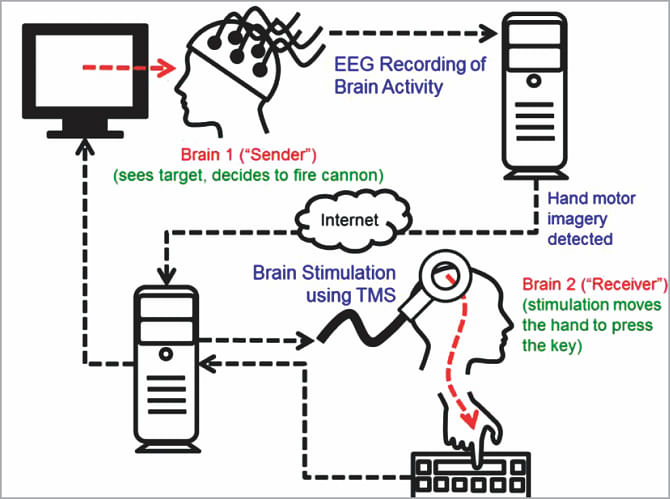'X-Men' mind control a reality?

Controlling the mind, and actions, of another person sounds like something from a sci-fi film, but researchers have taken a step closer to making it a reality.
A student, fitted with an EEG cap, has successfully controlled the hand of a friend when playing a video game using direct brain-to-brain communication.
And the reaction was immediate, despite the two players being in different locations and not being told when the game would begin.
During these early tests, researchers used brain stimulation to control the hands of another on a keyboard.
But these latest tests have improved the accuracy and effectiveness of the communication, and shown how it could soon be used in real-world examples.
To join the brains of UW student Darby Losey and Jose Ceballos, the research team used electroencephalography (EEG) and transcranial magnetic stimulation.
Losey was connected to an EEG machine, which reads brain activity and sends electrical pulses over the web in one room on the Washington-based campus.
These signals were sent to Ceballos, sitting in another campus half a mile away, who was fitted with a transcranial magnetic stimulation coil placed near the part of the brain that controls hand movements.
Losey was then told to think about firing a canon and intercepting rockets launched by a pirate ship on a video game.
Across campus, Ceballos was sitting wearing headphones in a dark room - with no ability to see the computer game - with his right hand positioned over a touchpad.
When Losey thought about firing the cannon, the signals were sent to Ceballos, whose hand then twitched, which pressed the touchpad and fired the cannon.
In total, three pairs of students took part in the experiment to test the technology's accuracy across different groups.
Researchers found that accuracy varied among the pairs, ranging from 25 to 83 percent.
Misses mostly were due to a sender failing to accurately execute the thought to send the “fire” command.
The researchers were also able to quantify the exact amount of information that was transferred between the two brains.
“The new study brings our brain-to-brain interfacing paradigm from an initial demonstration to something that is closer to a deliverable technology,” said co-author Dr Andrea Stocco, a research assistant professor of psychology and a researcher at UW's Institute for Learning & Brain Sciences.
“Now we have replicated our methods and know that they can work reliably with walk-in participants.”
Dr Rajesh Rao, a computer scientist and engineer at the University of Washington who led the work, added: “Our results show that information extracted from one brain can be transmitted to another brain, ultimately allowing two humans to cooperatively perform a task using only a direct brain-to-brain interface.
“Such devices, which have been long cherished by science fiction writers, have the potential to not only revolutionise how humans communicate and collaborate, but also open a new avenue for investigating brain function.”
A separate research team, from Starlab in Barcelona, Spain, recently published results showing direct communication between two human brains.
But that particular study only tested one sender brain, instead of different pairs, and was conducted offline instead of in real-time over the web.
The technology makes it possible to control the body of another person with thoughts - something that Professor Xavier was able to do in the X Men films and comics.
The UW research team is planning to take the work a step further in an attempt to decode and transmit more brain processes.
They are hoping to expand the types of information that can be transferred from brain to brain, including more complex visual and psychological phenomena such as concepts, thoughts and rules.
The research, published in Plos ONE, was funded by the US Army Research Office and the UW, with additional support from the Keck Foundation.
Earlier this year, a separate research team, led by the University of Barcelona, used EEG headsets to record electrical activity from neurons firing in the brain and send thoughts between participants.
This was used to convert the words “hola” and “ciao” into binary.
In the initial test, the greeting was sent from a volunteer in Thiruvananthapuram, India to Strasbourg, France.
There, a computer translated the message and then used electrical stimulation to implant it in the receiver's mind.

 For all latest news, follow The Daily Star's Google News channel.
For all latest news, follow The Daily Star's Google News channel. 



Comments